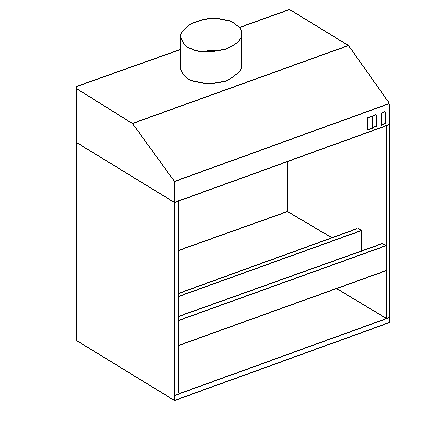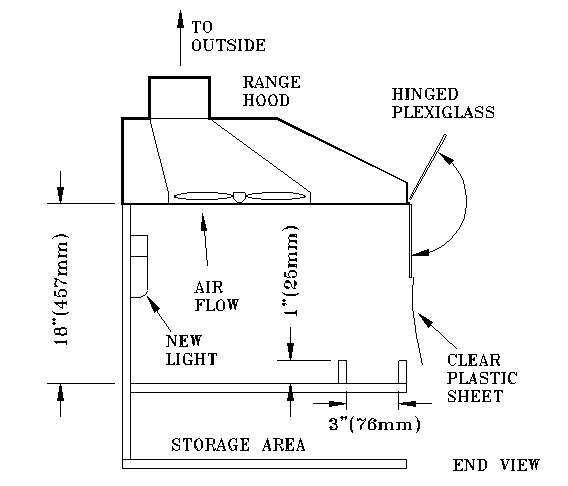Page 1 of 1
Inexpensive Paint Booths
Posted: Fri Sep 11, 2009 10:51 am
by gpraceman
Here's an article that I stumbled upon for an inexpensive spray booth.
http://books.google.com/books?id=tvYDAA ... q=&f=false
Might be good to keep that overspray under control. I like the turntable idea too.
Something like this
http://www.wikihow.com/Create-a-Paint-B ... our-Garage scaled down in size would also work. Make the PVC frame just big enough to fit the box fan and furnace filter combo. Make the frame so you can easily break down the booth to store until needed again.
Re: Inexpensive Paint Booths
Posted: Tue Sep 15, 2009 3:37 pm
by Darin McGrew
Interesting. Other than the addition of the box fan, that's very similar to our paint booths. The cheap turntables are very helpful. (So are disposable gloves and the spray handles that snap onto the top of spray paint cans.)
Re: Inexpensive Paint Booths
Posted: Tue Sep 15, 2009 5:34 pm
by Mr. Slick
So what would one do if one doesn't have access to a window?
The paint must be water based, right? Otherwise the fan would have to be explosion proof.
Do you have kids sanding while the paint booth is being used? I see a potential for dust problems. . .
Re: Inexpensive Paint Booths
Posted: Wed Sep 16, 2009 8:56 am
by gpraceman
Mr. Slick wrote:So what would one do if one doesn't have access to a window?
I saw one set of plans that used a smaller fan with flexible ducting to vent the exhaust (in this case, out a doggie door).
Mr. Slick wrote:The paint must be water based, right? Otherwise the fan would have to be explosion proof.
I'm not so sure that is a problem when painting small objects, such as derby cars. It would seem that the fume concentration would need to be pretty high in order to cause such a problem. Several of the setups that I saw on the web were for garage booths to paint cars. I'm sure that paint is not water based.
Mr. Slick wrote:Do you have kids sanding while the paint booth is being used? I see a potential for dust problems.
Somewhere I saw a schematic for a downdraft version of a paint booth. If you filter the intake and make some way to insert the car and your arm for painting it, then painting while cutting and sanding is going on, may be possible. Though, you would need to put the car into some type of container and move it to some less dusty place to dry. But if you are to do cutting/sanding and painting all in the same workshop, it would be better to have two different areas to do those operations.
For our Awana workshops, I provided three of them. Two for cutting and sanding and one was for finishing. This worked out pretty well. Though, many people would just do the painting at home.
EDIT:
Here's the downdraft schematic that I saw, as well as a couple of other options.

Maybe the downdraft with the top filter setup would work well enough in a dusty environment. You still need to put the cars in a more dust free location for drying.
Re: Inexpensive Paint Booths
Posted: Wed Sep 16, 2009 9:19 am
by gpraceman
I also found this on a model train forum, regarding explosion proof fans.
Most bathroom fans use induction motors that have no brushes, so they are effectively explosion-proof. There's no need to buy a fan that's specifically "explosion proof" because it'd likely be horribly costly.
No doubt you'll hear from people telling you that's horribly wrong and it won't work.
I've been using an old bathroom fan, with a standard induction motor, as a paint booth fan for years and have bumped (so to speak) large volumes of solvent-based paint fumes through it with no ill effects. Most of my painting is small model-size material using acrylic paint, but I also do some light manufacturing that involves volumes of rattle-can paint like Rustoleum. Due to the nature of the induction motor (no brushes, no sparks, no explosions) and the relatively small concentration of fumes, the setup works fine.
http://www.trainorders.com/discussion/r ... ?3,1603974
The key is the fuel to air mixture. With a high air volume (fresh air that is), you are not likely to get enough of a fume concentration to get combustion. I would still err on the side of having a fire extinguisher handy (a good precaution anyways for a workshop).
Using a fan where the motor is not in the airflow, like squirrel cage fans, will also help.
Re: Inexpensive Paint Booths
Posted: Wed Sep 16, 2009 9:45 am
by gpraceman
Here's one that uses a kitchen range hood. That would make it really easy to duct the exhaust.

 http://pages.interlog.com/~ask/scale/tips/booth.htm
http://pages.interlog.com/~ask/scale/tips/booth.htm
Re: Inexpensive Paint Booths
Posted: Wed Sep 16, 2009 6:18 pm
by ah8tk
Here is the plan for our paint booth using a squirrel cage fan and 2 furnace filters. With this type of fan you do not have the fumes running around the motor. Our booth will be vented out of the basement window. It has a Plexiglas cover on the front so when closed you could (not that I would) be sanding out front while the paint is curing.
Unfortunately I built the box and that is all the further I have gotten in the past 3 years (I have most of the other parts).

They currently sell paint booths that have a 3 stage filter. They say one can use these vent less (for water based paints).
spray booth
Re: Inexpensive Paint Booths
Posted: Wed Sep 16, 2009 6:27 pm
by Stan Pope
ah8tk wrote:Here is the plan for our paint booth using a squirrel cage fan and 2 furnace filters. With this type of fan you do not have the fumes running around the motor. Our booth will be vented out of the basement window. It has a Plexiglas cover on the front so when closed you could (not that I would) be sanding out front while the paint is curing.
...
Getting close! Next step is to emulate the baby incubators with gloves attached so that when in operation, the only air passing the car has been filtered.
Operation:
1. Put car and paint spray inside.
2. Seal the hood.
3. Turn on the fan for long enough to remove ambient dust.
4. Reach through the gloves to operate the paint spray.
Re: Inexpensive Paint Booths
Posted: Wed Sep 16, 2009 8:02 pm
by gpraceman
Stan Pope wrote:Getting close! Next step is to emulate the baby incubators with gloves attached so that when in operation, the only air passing the car has been filtered.
Operation:
1. Put car and paint spray inside.
2. Seal the hood.
3. Turn on the fan for long enough to remove ambient dust.
4. Reach through the gloves to operate the paint spray.
I'm not quite sure that one needs to go that far with this type of downdraft booth. I think as long as the top filter does not restrict the airflow too much, then the amount of "dirty air" coming in through the open front will not be excessive. If at least the top half of the front opening closed off (like with plexiglas), then any dirty air drawn in will be drawn right down to the filter. Place the car so it is not in that dirty air's path then it should just be exposed to the filtered air. If that works out that way, then it would be much more convenient, especially at a workshop with several cars to get painted. Trying to fully enclose the booth and work via gloves would probably not be so easy for many kids (or many adults, for that matter).
Re: Inexpensive Paint Booths
Posted: Wed Sep 16, 2009 8:22 pm
by FatSebastian
gpraceman wrote:I'm not quite sure that one needs to go that far with this type of downdraft booth.
We thought we were doing well if we shook the can up for more than 5 seconds and remembered to dump the crumbs from the pizza box that we use to catch the overspray.

Re: Inexpensive Paint Booths
Posted: Thu Sep 17, 2009 9:42 am
by Stan Pope
gpraceman wrote:I think as long as the top filter does not restrict the airflow too much, then the amount of "dirty air" coming in through the open front will not be excessive. If at least the top half of the front opening closed off (like with plexiglas), then any dirty air drawn in will be drawn right down to the filter. Place the car so it is not in that dirty air's path then it should just be exposed to the filtered air.
I think that the validity of the assumption (that "the top filter does not restrict the airflow too much") can be tested by running the vent for a few weeks and then looking at where the "trash" is accumulating in the bottom filter. My concern is that the relatively uninhibited flow of unfiltered air will not only dominate, but will mix with sufficient turbulance that dust will not be restricted to the front of the lower filter.
Two other aspects are of concern:
1. Does moving air carry more dust past the object being painted than still air? (I think that the answer is "yes".)
2. Does still air avoid depositing dust on the object being painted more than moving air?
The whole thing might make an interesting science fair experiment.

All that said, I think that these designs do appear to improve on "indoor painting in an open box", especially in my shop!
Re: Inexpensive Paint Booths
Posted: Thu Jan 13, 2011 10:11 am
by VWAffe
Here's a booth I made last year out of an old moving wardrobe box, my removable shop vac motor/blower, a trouble light, a spare furnace filter... and of course... duct tape. Basically... it was free, and works like a charm.
It's vented up an old, unused chimney flue, and puts a nice plume of steam out the chimney on bitter cold nights in January, but could easily be piped to work anywhere... mine just happens to be in the basement next to the chimney and boiler.
While contemplating it, I consulted a practicing industrial safety & health engineer in the family about the need for an explosion-proof motor (I planned to spray lacquers in this thing). Long story short, this thing moves so much air that you'll never remotely approach the LEL (Lower Explosive Limit) for any solvent used; so no explosion-proof motor required.
I haven't had any issues with much dust getting in our paint jobs, but you could easily build an enclosure out of plastic sheeting around it to mitigate that... a simple 1x2 lath frame up top held up by rope to give it shape, and another furnace/pollen filter or two in a wall to filter the dust out.
The glass filter pictured does a good job at catching most paint, but a few particles ended up on the blower vanes... a finer paper filter solves that easily. Air flow isn't a problem with either.









